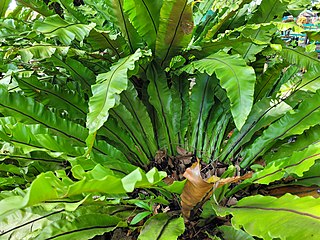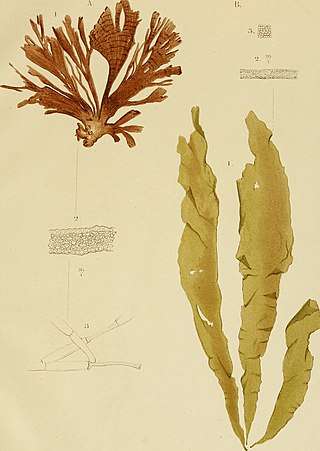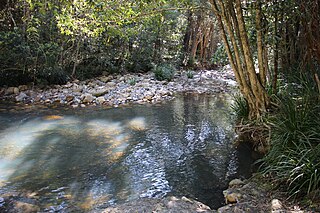
Asplenium is a genus of about 700 species of ferns, often treated as the only genus in the family Aspleniaceae, though other authors consider Hymenasplenium separate, based on molecular phylogenetic analysis of DNA sequences, a different chromosome count, and structural differences in the rhizomes. The type species for the genus is Asplenium marinum.

Cullen is a genus of legumes native to tropical, subtropical and arid regions of Africa, Asia and Australia. Despite the origin implied in the name of the constituent species Cullen americanum, legumes of this genus are not native to the Americas.

Asplenium nidus is an epiphytic species of fern in the family Aspleniaceae, native to tropical southeastern Asia, eastern Australia, Hawaii, Polynesia, Christmas Island, India, and eastern Africa. It is known by the common names bird's-nest fern or simply nest fern.

Geoglossaceae is a family of fungi in the order Geoglossales, class Geoglossomycetes. These fungi are broadly known as earth tongues. The ascocarps of most species in the family Geoglossaceae are terrestrial and are generally small, dark in color, and club-shaped with a height of 2–8 cm. The ascospores are typically light-brown to dark-brown and are often multiseptate. Other species of fungi have been known to parasitize ascocarps. The use of a compound microscope is needed for accurate identification.
This is a list of the flora of the Tubuai, an island in French Polynesia.

Asplenium australasicum, the bird's nest fern or crow's nest fern, is an epiphytic Australasian species of fern in the family Aspleniaceae.

Stypopodium is a genus of thalloid brown alga in the family Dictyotaceae. Members of the genus are found in shallow tropical and subtropical seas around Africa, Pakistan, India, Japan, Indonesia, Australia, Micronesia, the Caribbean, Venezuela, and Brazil.
Canarium australasicum, commonly named mango bark, brown cudgerie or parsnip wood, is a species of rainforest trees, of the plant family Burseraceae. They are endemic to Australia, in eastern Queensland and far northeastern New South Wales.

Glutinoglossum glutinosum, commonly known as the viscid black earth tongue or the glutinous earthtongue, is a species of fungus in the family Geoglossaceae. Widely distributed in the Northern Hemisphere, it has been found in northern Africa, Asia, Europe, and North America. Although previously thought to exist in Australasia, collections made from these locations have since been referred to new species. G. glutinosum is a saprophytic species that grows on soil in moss or in grassy areas. The smooth, nearly black, club-shaped fruitbodies grow to heights ranging from 1.5 to 5 cm. The head is up to 0.7 cm (0.3 in) long, and the stipes are sticky. Several other black earth tongue species are quite similar in external appearance, and many can be reliably distinguished only by examining differences in microscopic characteristics, such as spores, asci, and paraphyses. First described in 1796 as a species of Geoglossum, the fungus has gone through several changes of genera in its taxonomic history. It was placed in its current genus, Glutinoglossum, in 2013.

Glutinoglossum is a genus of six species of earth-tongue fungi in the family Geoglossaceae. The widespread type species, G. glutinosum, is commonly known as the "glutinous earth tongue". G. heptaseptatum is known only from the Czech Republic. Four additional species were described in 2015.

Glutinoglossum heptaseptatum is a species of earth tongue fungus in the family Geoglossaceae. Described in 2013, it is indistinguishable from its close relative G. glutinosum without the use of a microscope, and is known for certain only from the Czech Republic.
Glutinoglossum methvenii is a species of earth tongue fungus that was described as new to science in 2015. It is found in Australia and New Zealand, where it grows on moss and decaying logs in mixed deciduous forests. The specific epithet honours mycologist Andrew Methven.
Glutinoglossum exiguum is a species of earth tongue fungus that was described as new to science in 2015. It is found in Australia and New Zealand, where it grows on moss in mixed deciduous forests. The fruitbody is morphologically similar to that of Glutinoglossum australasicum, which is usually somewhat larger, more abundant, and has slightly wider and longer ascospores.
Glutinoglossum americanum is a species of earth tongue fungus that was described as new to science in 2015. It is found in the United States, where it grows on the ground, often among moss, in mixed deciduous forests.

Glencoe Creek, also known as Marowin Brook is a creek in Upper Rollands Plains, New South Wales, Australia. It is located in the Port Macquarie-Hastings Council area in the Mid North Coast region of New South Wales.
Codium australasicum is a species of seaweed in the Codiaceae family.
Sporolithon is a genus of red coralline algae in the family Sporolithaceae, in the order Corallinales.

Eriocaulon australasicum is an endangered monocotyledonous plant in the Eriocaulaceae family found in Australia, in Victoria, South Australia and New South Wales.

Spatoglossum is a marine brown algal genus in the family Dictyotaceae, with a worldwide distribution

Cullen australasicum, commonly known as tall scurf-pea or native scurf pea is a herbaceous, perennial shrub that is native to Australia.










